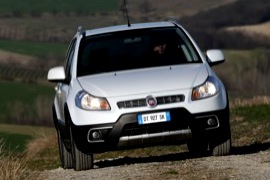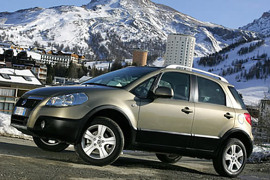FIAT Sedici Models/Series Timeline, Specifications & Photos
First production year: 2006
Engines: Gasoline, Diesel
Body style: SUV (Sports Utility Vehicle)
Fiat noticed the increased demand for crossovers, and it allied with Suzuki to create and build the Sedici, which was introduced on the European market in 2005 and then facelifted in 2009.
Since Europe switched to Euro 5 emission standards in 2009, all automakers had to comply with the new regulations. That forced most of them to either create or upgrade their existing models. So, the 2009 Sedici was just a heavily facelifted version of the already existing model.
With an original design signed by Giorgetto Giugiaro's design studio, the Sedici was a surprising appearance on the market. Not only that Fiat didn't have solid experience in building crossovers (apart from the Panda 4x4), but it didn't have the necessary tools to do it. So, the car was built on the same assembly lines as the Suzuki SX4 in Hungary. But Fiat was responsible for bringing the engines, and that's why it had a tougher job when the facelifted version started to take shape. But, like any other facelifted model, the car also got a revised design.
At the front, the 2009 Sedici sported a redesigned grille that resembled the one fitted on the Bravo/Brava lineup. Fiat tried to create a design signature, and it worked. The boomerang-shaped headlights swept-back to the sides created a sporty look for the vehicle. On the sides, depending on the trim level, the Sedici sported plastic moldings on the door panels and fenders.
The interior remained as spacious as before, but the Italian automaker added a touchscreen infotainment system on the options list, which it mounted on the center stack. Fiat installed a four-dial layout inside the instrument cluster with a wider speedometer and tachometer. In addition, it sported an LCD for the onboard computer.
Under the hood, Fiat installed a choice of two engines: a 1.6-liter gasoline and a 2.0-liter turbo-diesel. The former was available with a front-wheel drive version, while the latter was produced exclusively as an all-wheel-drive affair.
Even if Fiat had some history in producing 4x4 vehicles, it needed some help to develop a new crossover, and, for that, it made a deal with Suzuki, and the Sedici/SX4 duet was born.
By the mid-2000s, the crossover market started to expand, and customers turned their attention from station-wagons and MPVs to the new, all-wheel-drive vehicles. Fiat, together with Suzuki, developed the compact Sedici. It was a car big enough to handle well inside the cities but good enough for trips on unpaved roads. The Sedici (sixteen) name was chosen due to the 4x4 system; hence 4 x 4 equals 16.
Giorgetto Giugiaro designed it, and it might be one of the biggest mixes on the market at those times. It featured a bodywork, which was a mix between a station wagon and a minivan, a ground clearance bigger than a compact vehicle, and smaller than a 4x4. Fiat offered a version with a front grille that resembled the Doblo range, and a pair of swept-back, curved, headlights. The high greenhouse with a slightly raked tailgate design was inspired by the MPV segment. The moldings around the wheel arches and on the sides ensured good protection against the bushes and shopping carts as well.
Inside, the Sedici offered ample headroom for five passengers and higher-mounted seats, which led to better legroom. The rear seats featured a split-folding and tilting mechanism to expand the otherwise small trunk.
Fiat installed a choice of two engines under the hood: a naturally aspirated 1.6-liter with gasoline and a 1.9-liter turbodiesel. The former was available as a 2WD or all-wheel-drive. Fiat and Suzuki developed a semi-independent rear suspension for both all-wheel-drive and front-wheel-drive systems.

